
The manure management system at
North Carolina’s Rocky Creek Dairy is working just fine—the only
missing piece is a compost partner who can take care of the solids from
the operation, leaving dairy owner Ben Shelton and his staff free to
focus on the dairy.
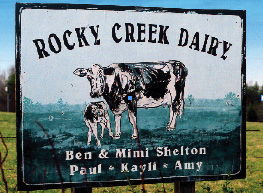
|
The manure management system at North Carolina’s Rocky Creek Dairy is working just fine—the only missing piece is a compost partner who can take care of the solids from the operation, leaving dairy owner Ben Shelton and his staff free to focus on the dairy.
Wanted: manure management partner. Must be able and willing to take manure from large dairy and convert it to compost at own operation. This opportunity is available immediately.
This above notice could likely be posted in any US state with a reasonable number of dairy operations. Some dairy operators are actively getting involved in separation and composting activities—many because they have ready-made local markets for the compost. But other dairyman, such as North Carolina’s Ben Shelton, would be quite happy to focus on their dairy operations and leave the composting to others.
Shelton, who is also a large animal veterinarian, operates Rocky Creek Dairy, a 1,250-head (milking and dry) operation near Statesville, which is equidistant from both Charlotte and Winston-Salem, in the eastern part of North Carolina.
Shelton set up Rocky Creek Dairy in 1992, buying an existing operation with 550 cows and then stepping it up to its current size—with a new parlor and freestall barn—six years ago.
Moving up to a larger dairy herd meant, of course, more manure, and Shelton set out to have at least some of that management, the composting side, done by an outside party.
“Our goal was to partner with someone that would take the solids, compost them, and develop a market for that compost on their own. We would not be involved with that side of things.”
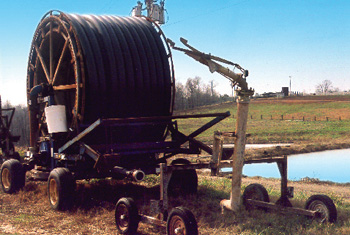 Using irrigation reels, Rocky Creek Dairy employs the reel and traveling gun method for applying liquids and also uses the drag hose approach, attaching the hose directly to a toolbar on its Massey Ferguson tractor. Using irrigation reels, Rocky Creek Dairy employs the reel and traveling gun method for applying liquids and also uses the drag hose approach, attaching the hose directly to a toolbar on its Massey Ferguson tractor. |
Initially they set up a business relationship with an outside environmental consulting company. But, as many industry people can attest, there’s quite a bit going on in manure treatment technologies these days. Some of the proposals and partnerships involving these various methods go ahead—and others, for various reasons, do not. The set-up at Rocky Creek Dairy fell into the second category.
With that business arrangement now history, Shelton is moving on to “Plan B,” and looking to find another partner who would be willing to take on the composting.
The manure management system on the Rocky Creek farm is working fine—they are just left with solids that they would prefer others would handle.
A key part of their system is a Sweco separator, which has been in place for about two years and was purchased on the advice of the consulting company. About half-a-dozen separation systems were studied, with small prototypes set up on the farm to see what would perform best. The conclusion: The Sweco system did the best job of getting the most solids out of the manure stream, and they went with it.
While Sweco may not be as well known as other manufacturers of separation equipment for the ag industry, it has more than 60 years of separation technology experience, and also serves the pharmaceutical, chemical, food, paper and other industries with a line of separation, sizing and milling equipment.
The company’s round separators separate solids from liquids or segregate dry materials into various sizes. Particles as fine as 400 mesh (37 microns) can be screened, with up to four screen decks incorporated in one Sweco separator.
Shelton notes they have made modifications to the separator, and that there have been some problems with solids stopping up the valves. “It’s been a learning process for us, but overall we are satisfied with the screen system. Going this way, we just felt we could get our water cleaner to flush with—and our spray water cleaner—if we could do a better job of separating the solids with a mechanical separation system.”
Their handling system also involves a gravity system sand trap, designed by Florida agricultural engineering consultant Jake Martin, which was added when the new barn was built. “We really wanted to get some of the sand out of the manure and recycle it.”
Rocky Creek Dairy has five manure storage holes, with a total capacity of five million gallons. The first hole captures the solids coming off the separators, with the second a settling basin that captures the smaller solids that get by the screen. The water is aerated in the third hole with Aeromix AE46A aerators. The last two holes are storage, with liquid pumped directly from there to the barns for flushing, and for application to their acreage.
“Our goal is to get our water on the back end of the system down to less than two pounds of nitrogen per 1,000 gallons of water, and we’d be able to accommodate that with spraying on our 100 acres,” Shelton explains. “We don’t want to have a whole lot of land to take the liquid side of the manure. Our goal on the solids side is to still partner with someone that would take our solids. We’re still hoping we can hook up with the right partner.”
By design, Rocky Creek purchases most of their corn silage, so they don’t have the land—outside of that 100 acres—that could benefit from spreading the solids. Right now, their solids are spread on about 700 acres locally, including 250 acres this year that they rented and which will be put in hay. “From an overall nutrient standpoint, we are not gaining that much from applying it,” notes Shelton.
Shelton says that they are not looking to get that much, financially, out of the solids side. “We’d just rather not have to deal with the solids handling and spreading.” At this point, they have a few customers who are taking a small amount of the solids, but they are really looking for a single partner who will take all of it.
As with virtually all states, their manure-related activities are heavily regulated. In terms of regulations covering manure management in North Carolina, there have been two very defined eras: Pre- the Big Spill and After the Big Spill. There were state regulations prior to the big hog lagoon spill problems in North Carolina in 1995—and there was a significantly different, and far more demanding, set of regulations following. And those more demanding regulations extend to all livestock operations, including dairy, in the state.
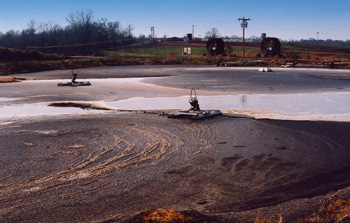 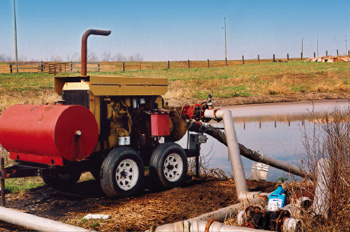 Rocky Creek Dairy has five manure storage holes, with a total capacity of five million gallons. Liquids are aerated in the third hole (left) with Aeromix AE46A aerators. Rocky Creek Dairy has five manure storage holes, with a total capacity of five million gallons. Liquids are aerated in the third hole (left) with Aeromix AE46A aerators. |
“Things were definitely escalated by the spill episode and the dairy industry kind of got caught in the backlash,” says Shelton. “We’ve gone through the process of the regulations that evolved after those problems with the hog operations.”
Basic water quality legislation in North Carolina is covered under the “.0200 rules” which, among other requirements, state that all livestock operations must have a waste management plan. In addition to its own detailed plan, Rocky Creek also has the required National Pollutant Discharge Elimination System (NPDES) permit. “That’s where we are now in terms of regulations,” says Shelton, who knows his stuff in this area, being a certified waste operator.
On the farm, one employee spends about 75 percent of his time on manure management, or manure management related tasks, Shelton estimates. That person deals with the separator and its screens, pumps and the irrigation reels, and the servicing entailed with this equipment. On the pump side, most of their equipment is from Houle. They have a Houle 1903 electric pump that moves water from the third hole to the flush area. They recently purchased a new Amadas 2000 Reel Rain reel system, which is working out well so far.
With the solids, the dairy does some of its own application with a Kuhn Knight ProTwin slinger and contracts out the remaining application.
With the irrigation systems, they often take a drag hose approach. So, instead of running the reel out with a traveling gun, they attach the hose directly to a toolbar on their Massey Ferguson 6480 tractor, which applies the liquid over a 12- to 14-foot wide area. “It’s more efficient,” says Shelton. “We can cover a bigger area and apply more water per hour.” Several other farms in the area have also adopted this method.
In the winter, when they have their small grains coming up, they will, of course, use the regular reel and traveling gun approach. “But as soon as that crop comes up, we’ll be right back out there with the hose and tractor.”
Rocky Creek has opted to contract a specialist to take care of their manure records. They hired a nearby county agent, who is familiar with the all the regulations and records required. She receives their manure sample and soil sample information, manure hauling records, spray records and enters all this into a computer program, which generates the required records. What she puts together definitely helps Rocky Creek with the regulatory officials. Generally, inspectors are able to review the information in a couple of hours, with few, if any, questions. “She knows exactly what they want in terms of technical information, and presents it in a professional way.”
Looking to the future, Shelton would like to see Rocky Creek achieve some very specific results with its manure management system. “What would make a difference for us is if we could have a process that takes the nutrient out of the water, and treats the water for bacteria, and either discharges it or puts it back in our system for cattle drinking water.”
One approach they investigated involved building a small wetland on the farm that would take the water and purify it to the extent that it could be used as drinking water for the cattle. There is apparently federal funding available for such projects, but Shelton found out it was only available for operations with less than 700 cows, which leaves them out.
“That seems like a backwards policy in that it’s the larger herds that would really be able to utilize those kind of systems,” he says. “It would have been a real learning situation for us if we could have made that happen.
“And I still feel that from a water quality standpoint, that’s where manure management needs to get to. With that kind of set-up, you’re not worried if it rains a lot and the land is too wet to get on for application, or about run-off or nutrient load. If we as an industry can get to the point where we can recycle that water, it becomes an asset.”
These kinds of projects, however, are not possible without government funding, he says, because of the large capital expenditures involved. Government support in general for the dairy industry would be welcome in North Carolina, Shelton notes. The state government is preoccupied with the state’s hog industry, which is not a big surprise considering its size and past problems.
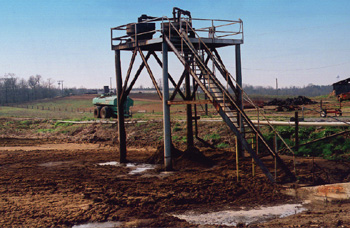 The manure management equipment at Rocky Creek Dairy includes a Sweco separator. To get direction on which separation equipment to purchase, small prototypes of various systems were set up on the farm—the Sweco system did the best job of getting the most solids out of the manure stream. The manure management equipment at Rocky Creek Dairy includes a Sweco separator. To get direction on which separation equipment to purchase, small prototypes of various systems were set up on the farm—the Sweco system did the best job of getting the most solids out of the manure stream. |
While dairy operations in the state have become larger in the last five to ten years, the industry is still shrinking overall. This comes in spite of significant population growth in the southeastern US, and growing demand for milk and milk products. Rather than continuing to see dairy operations set up in the western states, the state government could easily encourage dairies to set up in eastern North Carolina, Shelton feels. “But one of the limiting factors is the waste management approval system.”
Rocky Creek’s own decision to grow a half-dozen years ago was, in hindsight, a particularly wise move. “We kind of had a choice there—to go ahead and borrow the money to invest for the future or wear out what we had,” explains Shelton. “I feel we made the right decision then, especially in light of how much more cows cost today and how much more it costs to build a facility than it did six years ago.”
Shelton says they would consider further growth for the dairy, but it would again be dependent on finding that composting partner. They recently talked with someone proposing mixing dairy manure with chicken litter. There’s a large poultry industry in the region, and some producers are struggling to get enough landbase to apply their litter.
And expanding the dairy could also open other doors in terms of manure management. They’ve looked into manure digesters. “But at this point, we’re not big enough from an economy of scale standpoint. But a digester might make more sense if we expanded the dairy,” says Shelton. “There’s a few ways we can go.”